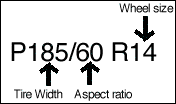WebCars! Tire/Wheel Compensation Calculator
WebCars! Tire/Wheel Compensation Calculator
 Car enthusiasts seem to have one thing in common: they cannot leave things as they are. They are constantly changing their cars, and there is an entire aftermarket industry to support the habit.
Car enthusiasts seem to have one thing in common: they cannot leave things as they are. They are constantly changing their cars, and there is an entire aftermarket industry to support the habit.
Probably the most commonly upgraded item is the wheels and tires. But changing the wheels and tires from what was originally delivered by the factory has a side effect: because the wheel/tire combination has been changed, the accuracy of the speedometer is affected.
Another fact often overlooked is that the wheels form a very important function: They are part of a series of gear ratios between the engine and the road. When you change the size of your tires, you are also changing the gear ratios, not unlike shifting into another gear. Since the speedometer relies on this gear ratio for accuracy, its readings will be different.
In most cases, the change to a different size tire/wheel will produce only a negligible difference in the gear ratio. If the change is significant however, you may want to make other changes to keep the gear ratios similar to the way the manufacturer intended. A good example of a radical change is adding offroad tires to a truck.
The easiest way to change the overall gear ratio is to change the gears in the differential. In some cases, aftermarket suppliers offer the necessary parts and often the vehicles' manufacturer has an excellent selection available. If you are on a budget, a little research will probably reveal that your vehicle was available with a number of differential ratios. Different engines and transmissions, even the model year were equipped with differential ratios that sutied various conditions. If that is the case, a little searching of automobile wrecking yards can produce bargains.
Another thing car enthusiasts have in common: a deep, almost fanatical desire to know what is going on in their cars. To accomodate both the wheel chnaging habit and the desire to know the consequences thereof AND to be prepared to deal with them, we offer the WebCars! Tire/Wheel Compensation Calculator.
To use the WebCars! Tire/Wheel Compensation Calculator, you will need to know the size of the original wheel/tire and the size of the upgraded wheel/tire. The form below will accept either the size of the tire (as found printed on the sidewall) or the circumference. The preferred method would be to measure the tire, since that would be the most accurate.
To measure the circumference of a tire: Obtain a fleixble vinyl tape measure, available at any sewing shop or as part of the tool kit of your nearest seamstress. The procedure is to lay the tape on the ground ahead of the wheel/tire, and then roll the car a foot or two until it is on top of the tape measure which will allow you to get a circumference reading. A better way is to just measure the circumference with the wheel/tire off the car, if that is possible. If you happen to be in the middle of upgrading your wheels/tires, that is the easiest time to take the measurement. If your car has different sized tires for the front and rear, measure one of the rear tires.
When you have the "before and after" sizes of your tire/wheels, you can plug the figures, along with the differential ratio (sometimes called the "final drive ratio") available from your owners manual, into the fields below and click on "Calculate Speedometer Correction." You will then see a table that will tell you how far off your speedometer will be and what the differential gear ratio you will need to install to retain the overall gear ratio you had before.
 When measuring the circumference, it is necessary for the original equipment and aftermarket tires to be the same approximate temperature. In most cases this means cold, as that is usually easiest and most pracatical. The reason is that air pressure, and therefore tire size will change as the tire warms up. Some enthusiasts specify that their tires be filled with nitrogen instead of air since air contains water which causes the temperature related tire size changes. Nitrogen, which does not contain water, eliminates the problem, an important consideration for driving in the hot desert.
When measuring the circumference, it is necessary for the original equipment and aftermarket tires to be the same approximate temperature. In most cases this means cold, as that is usually easiest and most pracatical. The reason is that air pressure, and therefore tire size will change as the tire warms up. Some enthusiasts specify that their tires be filled with nitrogen instead of air since air contains water which causes the temperature related tire size changes. Nitrogen, which does not contain water, eliminates the problem, an important consideration for driving in the hot desert.
|
|
| Wheel size (inches): | |
| Tire width (mm.): | |
| Aspect ratio: |
| Wheel size (inches): | |
| Tire width (mm.): | |
| Aspect ratio: |
| Differential Ratio: |

Suggestions? Comments? Tell us!!! |
Return to
|
| Thanks to Kevin Lakkis of Toyo Tire for his help. | |